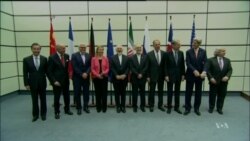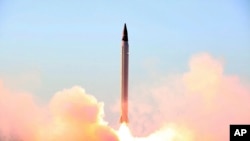October 18 has been dubbed Adoption Day - when both sides begin taking steps to carry out the provisions of the Iran nuclear deal, known as the Joint Comprehensive Plan of Action (JCPOA).
A provision in the nuclear agreement, which negotiators reached in July, required Adoption Day to occur 90 days after the deal was endorsed by the U.N. Security Council. The council backed the deal on July 20, which, in essence, set this Sunday's deadline for both sides to begin compliance.
Work cut out
Iran has its work cut out for it as it begins taking the steps could lead to the eventual lifting of crippling international sanctions.
Its tasks include removing thousands of centrifuges - machines that separate substances of different densities as part of the enrichment process. It also has to reduce its overall uranium enrichment capacity, make significant modifications to its Arak heavy water reactor and provide access to International Atomic Energy Agency (IAEA) inspectors who will monitor its compliance at nuclear-related sites.
If the IAEA verifies that Iran is in compliance with terms of the nuclear deal, Iran and world powers move to Implementation Day, which includes the rolling back of nuclear-related international sanctions.
Secretary of State John Kerry says a finalized deal could have ramifications for years to come.
“The Middle East remains a deeply troubled place, but every problem in the region would be made much worse if countries were to move towards nuclear weapons,” he said in a speech at Indiana University this week.
“The Iran agreement is the best way to ensure that this possibility is foreclosed now and for all time,” he added.
Iranian missile test raises tensions
Ahead of Adoption Day, Iran muddied the waters by test-firing a medium range missile that may be capable of delivering a nuclear weapon.
While the test does not violate provisions in the Iran nuclear deal, such tests are a violation of a U.N Security Council resolution.
While Iran’s ballistic missile test does not violate the “letter” of the JCPOA, it does violate the “spirit” of the agreement, said Ilan Berman, Vice President of the American Foreign Policy Council.
“The (U.S.) administration, I think, made a tremendous strategic error in agreeing with the Iranians to take ballistic missiles out of the scope of the work of the JCPOA, and it is an effort that I think we are paying for now,” he said.
Potential windfall for Iran
In spite of those concerns, Stratfor analyst Reva Bhalla said if Iran can meet the conditions that lead to sanctions relief, it could economically rehabilitate itself.
“In the immediate sense, it means between 40 and 50 million barrels of oil that Iran has in storage will be released on the market,” she said.
But as Iranian officials work to get their nuclear sites into compliance, they will need to sell the deal to the country’s hardliners, said Berman.
“They have to sell their constituency that the Islamic Republic has not changed its stripes, ideologically, despite the deal,” he said.
Berman also said there is concern about whether Iran would remain in compliance once it begins reaping the benefits of sanctions relief.











